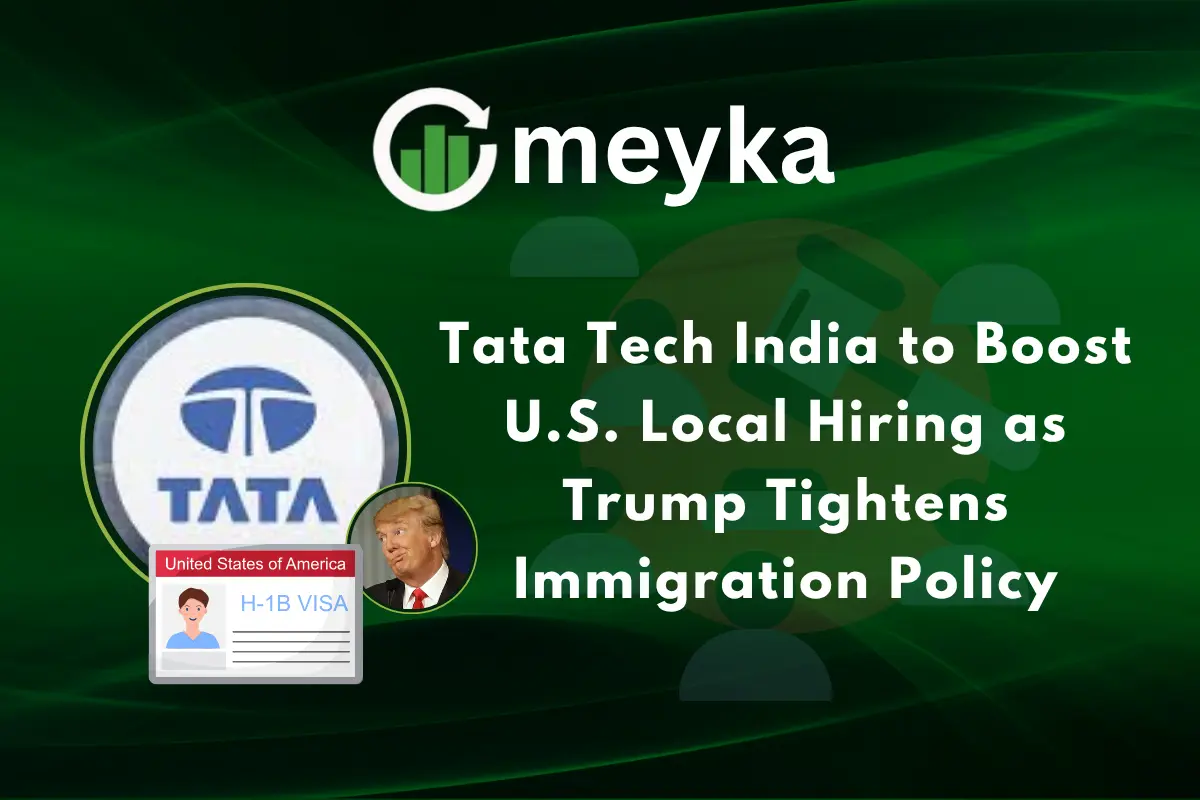Tata Tech India to Boost U.S. Local Hiring as Trump Tightens Immigration Policy
On October 23, 2025, the Indian engineering firm Tata Technologies announced it would hire more U.S.-based workers in response to the tightening of American immigration and visa rules. The company’s CEO, Warren Harris, said the move comes as the U.S. government introduces steep fees for H-1B visas and strengthens its push for local employment. Tata Technologies already earns about one-fifth of its revenue from North America and supports clients in the automotive and aerospace sectors.
This shift is significant. It signals stronger U.S. job-market protectionism and shows how global firms are adjusting in real time. For an Indian firm that has relied heavily on global talent flows, the pivot to local hiring in the U.S. carries both opportunities and risks.
Let’s explore why Tata Technologies made this move, what it means for the broader industry, and how it reflects the changing global labour and visa process.
Tata Tech India: Background and Context
Tata Technologies is an engineering and product-development firm. The company works with carmakers, aerospace firms, and heavy-equipment makers. It has more than 12,000 employees worldwide. About one-fifth of revenue comes from North America.
The U.S. has tightened rules on skilled visas in 2025. In September 2025, the White House added a new annual fee that can reach $100,000 for some H-1B petitions. That step shocked many firms and set off court challenges. The fee aims to reduce foreign hires and push companies to recruit domestically.
Indian firms long relied on H-1B and other visa routes to staff U.S. projects. The recent policy change forces a rethink. Large service firms had already begun shifting some hiring to local markets. The new rules speed up that process.
Tata Technologies’ Strategic Response
Tata Technologies announced on October 23, 2025, that it will hire more U.S.-based workers. CEO Warren Harris framed the change as an operational response to new U.S. visa costs and regulations. The company said it expects to keep growing in North America despite the headwinds.
Hiring locally reduces visa risk. It also builds stronger client relationships. Local staff can be on-site quickly. They know local standards and can respond faster. For certain engineering roles, proximity matters. Clients often prefer face-to-face work in the design and testing phases.
The company still values its global delivery model. Offshore teams will continue to handle scalable and routine tasks. Local hiring will be used for client-facing roles, integration work, and specialised engineering that needs close collaboration with U.S. customers. This hybrid model aims to protect margins while meeting new rules.
Implications for India-based Service Firms and U.S. Employers
The move by Tata Technologies signals a larger shift in the sector. Indian engineering and IT firms may follow. Local hiring raises payroll costs. It also changes the talent pipeline. Firms will invest more in U.S. university recruiting and local training programs.
For U.S. workers, the change can mean more job openings. For employers, higher local salaries may push up contract prices. Smaller firms may struggle the most. Larger firms can absorb higher labor costs or pass them to clients.
Clients might accept higher fees for more local talent. Many U.S. manufacturers value local knowledge. They may also value supply-chain resilience. A greater local footprint can become a selling point in future bids.
Challenges and Tradeoffs for Tata Tech India
Hiring locally is not a simple switch. Skilled engineering talent is unevenly distributed across the U.S. Some regions face shortages. Rapid recruitment requires new HR systems. It also requires training and cultural integration of new teams.
Cost is a major issue. U.S. engineers usually command higher wages than their offshore counterparts. Replacing a large pool of offshore staff with local hires can shrink margins. Firms must balance price competitiveness with compliance and client expectations.
There is also execution risk. Opening new offices, setting up HR infrastructure, and securing local vendors takes time. Companies that move too quickly risk poor hires or wasted investment. Those that move too slowly face regulatory penalties and disrupted projects.
Policy and Industry Ripple Effects
The H-1B fee changes are already drawing legal and political pushback. Industry groups, universities, and some state governments have filed lawsuits and public statements. The future of the policy could shift through court rulings or new legislation.
If the fee remains, expect more localisation. Companies will expand U.S. campuses. Vocational programs and STEM outreach may grow. Universities may benefit from closer ties to industry. Trade and policy debates will focus more on talent pipelines and training.
At the same time, some innovators will seek alternatives. Firms might restructure roles so that highly specialised work remains offshore. Automation and AI tools could replace some routine tasks. In financial and investment analysis, tools such as an AI stock research tool might be used to model how local hiring affects margins and valuations.
Tata Tech India: What to Watch Next?
Key signals include hiring announcements, new U.S. offices, and acquisition activity. Tata Technologies noted targeted acquisitions as part of its strategy to strengthen capabilities. Any rapid expansion into U.S. hubs will show whether the localisation push is deep or limited.
Monitor legal cases over the H-1B fee. Court outcomes could restore prior rules or limit the fee’s scope. Also, watch client contracts. If clients accept higher fees for local work, localisation will accelerate. If clients resist, firms will need more creative delivery models.
Wrap Up
Tata Technologies’ pivot to hire more U.S. staff reflects a changing global labour landscape. The move reduces visa exposure. It strengthens local ties with clients. But it also brings higher costs and execution risk. The success of this strategy will depend on talent access, efficient local hiring, and how policy and courts shape the visa rules in the coming months.
Frequently Asked Questions (FAQs)
On October 23, 2025, Tata Technologies said it will hire more U.S. workers due to new visa fees and rules. This helps reduce risk and stay close to clients.
In 2025, the U.S. introduced higher fees for H-1B visas, up to $100,000 for some companies. The goal is to encourage more local hiring and reduce foreign workers.
Hiring more U.S. workers may increase local tech jobs. However, total impact depends on company needs, costs, and how many roles shift from offshore to the U.S.
Disclaimer: The content shared by Meyka AI PTY LTD is solely for research and informational purposes. Meyka is not a financial advisory service, and the information provided should not be considered investment or trading advice.






